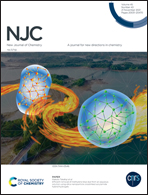Conformational isomerism involving the carboxylate groups of a linker in metal organic frameworks and its distinctive influence on the detection of ketones†
Abstract
In this work, the influence of solvent and reaction conditions (solvothermal vs. room temperature) on the product formation is analyzed using two Zn(II) MOFs, {[Zn(bpaipa)]·DMF·2H2O}n (1) and {[Zn(bpaipa)]·5H2O}n (2), where H2bpaipa = 5-(bis(pyridin-2-ylmethyl)amino)isophthalic acid. Both 1 and 2 are isolated in >80% yields from the reaction of Zn(OAc)2·2H2O and H2bpaipa under solvothermal and ambient conditions, respectively. With a difference in lattice solvent accommodation inside their pores, 1 and 2 are rare examples of conformational isomerism involving the carboxylate groups of bpaipa as determined by their single crystal X-ray structures. Using N2 adsorption experiments at 77 K, the difference in their pores was also verified. Their bulk phase purity and crystallinity were established by powder X-ray diffraction. Both 1 and 2 are thermally stable but 1 is more stable than 2 as demonstrated by the thermogravimetric analysis. Interestingly, their luminescence properties in different solvents are also influenced by such a structural difference. Utilizing the luminescence behavior of 1 and 2, the selective and sensitive detection of various ketones, including acetone and cyclohexanone (for an indirect sensing of RDX), is explored in three different solvents.



 Please wait while we load your content...
Please wait while we load your content...